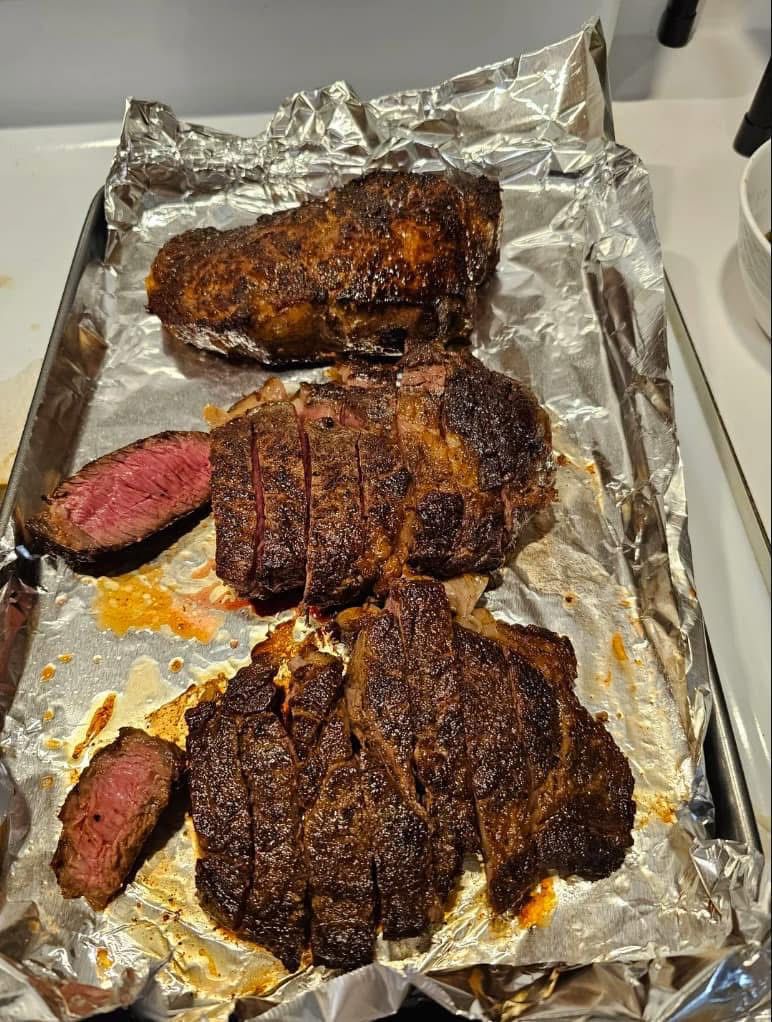ADVERTISEMENT
### **How to Cook Ribeye Steak to Perfection**
#### **Step 1: Prepare the Steak**
1. Remove the **ribeye steaks** from the refrigerator about 30 minutes before cooking to allow them to come to room temperature. This helps ensure even cooking.
2. Pat the steaks dry with paper towels to remove excess moisture. This is key to achieving a crispy, golden crust.
3. Season generously with **salt** and **black pepper** on both sides. Feel free to add any other seasonings or herbs you prefer, but simplicity often works best with ribeye to let the natural flavors shine.
#### **Step 2: Heat Your Pan**
1. Heat a heavy skillet or cast-iron pan over **medium-high heat**. Let it get hot, but not smoking.
2. Add **2 tablespoons of olive oil** to the pan and swirl to coat the bottom. The oil should shimmer and sizzle as it heats up.
#### **Step 3: Sear the Steak**
1. Once the pan is hot, carefully place the steaks in the skillet. You should hear a satisfying sizzle—this means you’re on track for a delicious sear.
2. For a **medium-rare** steak, cook the ribeye for **4-5 minutes per side**. Adjust the time based on your preferred level of doneness:
– **Rare**: 2-3 minutes per side
– **Medium**: 5-6 minutes per side
– **Well-done**: 7-8 minutes per side
3. **Tip**: Do not move the steak around in the pan! Let it form a crust. If you try to flip it too early, it may stick to the pan and break apart.
#### **Step 4: Add Flavor**
1. When you flip the steak for the second side, add **2 tablespoons of butter**, **3 smashed garlic cloves**, and **fresh thyme or rosemary sprigs** (optional).
2. As the butter melts, tilt the pan slightly and use a spoon to baste the steak with the melted butter. This will enhance the flavor and help keep the steak moist.
#### **Step 5: Check for Doneness**
1. Use a **meat thermometer** to check the internal temperature. Here are the key ranges:
– **Rare**: 120°F (49°C)
– **Medium-rare**: 130°F (54°C)
– **Medium**: 140°F (60°C)
– **Medium-well**: 150°F (66°C)
– **Well-done**: 160°F (71°C)
2. If you don’t have a thermometer, the touch test can also help. Gently press the steak with your finger: a rare steak will feel soft, while a well-done steak will feel firm.
#### **Step 6: Rest the Steak**
1. Once the steak has reached your desired doneness, remove it from the skillet and transfer it to a plate or cutting board.
2. Let the steak **rest for 5-10 minutes** before slicing. This helps the juices redistribute throughout the meat, ensuring a tender, juicy bite.
—
### **Serving Suggestions**
– **Sides**: Pair your ribeye steak with classic sides like **roasted potatoes**, **garlic mashed potatoes**, or a fresh **green salad**. You can also serve it with grilled vegetables or steamed asparagus for a lighter option.
– **Sauce**: If you’re feeling indulgent, consider topping your steak with a **garlic butter sauce**, **mushroom sauce**, or a simple **chimichurri** for an extra burst of flavor.
– **Wine Pairing**: A bold **red wine**, like Cabernet Sauvignon or Merlot, complements the rich flavors of the ribeye steak perfectly.
—
### **Why You Should Try This Ribeye Steak Recipe**
This **Ribeye Steak recipe** is simple, elegant, and sure to impress. The combination of the crispy seared exterior, the tender interior, and the delicious buttery flavor makes this one of the best ways to enjoy a steak at home. It’s perfect for a special occasion or even a weeknight treat that feels like a celebration.
So, whether you’re cooking for a crowd or just treating yourself to a high-quality meal, don’t miss out on this easy, foolproof ribeye steak recipe. Once you try it, it’ll become your go-to method for making steak—no need for a steakhouse reservation ever again!
ADVERTISEMENT
